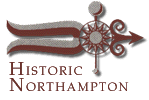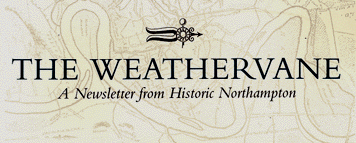

|


Weathervane Newsletter Summer 2002

Three Cheers for "The Hurrah Game": Baseball History Comes Home
Part of the city's storied baseball history, long on display at the National Baseball Hall of Fame is the centerpiece of a new exhibit and a new book at Historic Northampton. "The Hurrah Game": Baseball in Northampton 1823-1953, explores the colorful history of America's pastime in Northampton, including legendary baseball greats who began their careers in the sport's earliest years. The show features artifacts, rare photographs, art, cartoons, poetry, and old newspaper articles that bring to life Northampton's long association with every variety of organized baseball. It contains memorabilia, from the museums collections, local donors and objects on loan from other collections, including the Baseball Hall of Fame. The exhibit runs through August 16, 2002.
Guest curators Brian Turner and John Bowman have uncovered a fascinating portrait of Northampton's amateur, independent, minor league and semi-pro ball clubs. Turner has published articles on local baseball history, including an essay on the Florence Eagles in the forthcoming annual publication of the Society of American Baseball Researchers, The National Pastime. Bowman is the co-author of several highly regarded histories of baseball including Diamonds in the Rough.
Turner and Bowman have also co-authored a well-received book, based on their extensive research, which has been published to accompany the exhibit. The 80 page illustrated book, The Hurrah Game, is available at Historic Northampton. This comprehensive history of the game in Northampton and its neighboring communities expands upon the text and illustrations on display at the museum. Mark Alverez, former Publications Director for the Society of American Baseball Researchers had this to say about the book: "It is important to be reminded that baseball was our national Pastime not because of the far-away major leagues, but because the game was played all over the country as it was right here."
The exhibit and book break new ground in the history of American baseball. The remarkable story of Luther Askins offers evidence that the Florence Eagles ball club of the 1860s played a significant, yet previously unrecognized role in the integration of baseball. Askin, a first baseman for the Florence Eagles until 1866, was a light-skinned African-American. But the subject of his race went unspoken as the Eagles played in communities where black players may not have been welcome.
Turner said, "There's a strong case that the Florence Eagles integrated amateur baseball before anyone else, even if they elected not to make the fact known. This silence, lasting more than 50 years, was something that Askin himself assisted in, for reasons the exhibit makes clear."
Turner and Bowman believe the exhibit will surprise visitors with an entertaining and informative array of materials that reveal the ways in which baseball evolved in the Pioneer Valley. Bowman said that bat and ball games were played earlier than people realize. "A former student of the Round Hill School in Northampton recalled 'base ball' being played in 1823. An 1844 diary refers to "Bat Ball" in Florence," Bowman said.
Northampton is only one of the Pioneer Valley communities for which baseball was an exciting source of community pride and entertainment. In the 1860s, a Western Massachusetts championship offered a silver ball crafted by Ames Manufacturing of Chicopee, a renowned maker of swords. "The Florence Eagles held the silver ball for several months in 1866, a point of pride for the folks in this area," Turner said.
While the silver ball itself has disappeared, other memorabilia have been discovered and assembled for Northampton's special exhibit. The original Eagles team belt buckle is on loan from the Baseball Hall of Fame in Cooperstown, NY. Also on display is a late-nineteenth-century bat, discovered by a local family. Both belt and bat can be traced to Jonas Polmatier, one of the Florence Eagles.
Contents Historic Northampton.